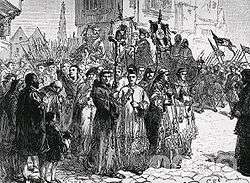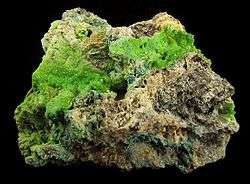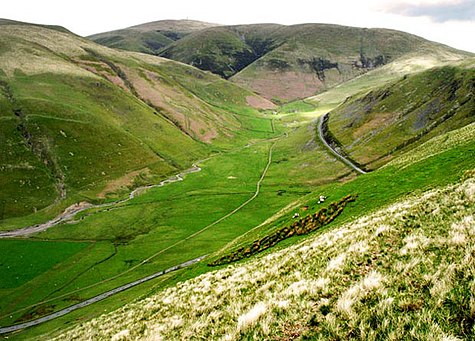Bevis Bulmer
Sir Bevis Bulmer (1536–1615) was an English mining engineer during the reigns of Elizabeth I and James I. He has been called "one of the great speculators of that era".[1] Many of the events in his career were recorded by Stephen Atkinson in The Discoveries and Historie of the Gold Mynes in Scotland, compiled in part from a lost manuscript by Bulmer entitled Bulmer's Skill.
Family

According to Tyson, Bevis Bulmer's "origins are shrouded in mystery".[2] However according to other sources, Bevis Bulmer, born in 1536, was the son of Sir John Bulmer, eldest son and heir of Sir William Bulmer (d.1531).[3][4][5] His mother was Margaret Stafford, said to have been an illegitimate daughter of Edward Stafford, 3rd Duke of Buckingham.[4][6]
His parents were said to have been drawn into the rebellion of Robert Aske, known as the Pilgrimage of Grace, through the influence of their nephew, Sir Francis Bigod.[7] They were executed with others in early 1537 for their involvement, in consequence of which their lands escheated to the Crown,[4] although some were granted at a later date to Sir George Bowes (1527–1580).[8] The circumstances of their trial and execution were recorded by the author of Wriothesley's Chronicle:[9][10][11]
Also the 16 day of May [1537] there were arraigned at Westminster afore the King’s Commissioners, the Lord Chancellor that day being the chief, these persons following: Sir Robert Constable, knight; Sir Thomas Percy, knight, and brother to the Earl of Northumberland; Sir John Bulmer, knight, and Ralph Bulmer, his son and heir; Sir Francis Bigod, knight; Margaret Cheney, after Lady Bulmer by untrue matrimony; George Lumley, esquire;[12] Robert Aske, gentleman, that was captain in the insurrection of the Northern men; and one Hamerton, esquire, all which persons were indicted of high treason against the King, and that day condemned by a jury of knights and esquires for the same, whereupon they had sentence to be drawn, hanged and quartered, but Ralph Bulmer, the son of John Bulmer, was reprieved and had no sentence.
And on the 25 day of May, being the Friday in Whitsun week, Sir John Bulmer, Sir Stephen Hamerton, knights, were hanged and headed; Nicholas Tempest, esquire; Doctor Cockerell, priest;[13] Abbot quondam of Fountains;[14] and Doctor Pickering, friar,[15] were drawn from the Tower of London to Tyburn, and there hanged, bowelled and quartered, and their heads set on London Bridge and divers gates in London.
And the same day Margaret Cheney, "other wife to Bulmer called", was drawn after them from the Tower of London into Smithfield, and there burned according to her judgment, God pardon her soul, being the Friday in Whitsun week; she was a very fair creature, and a beautiful.
Early years
Bulmer began his mining career at some of the former Bulmer properties at Wilton, North Yorkshire, and is said to have been interested in his youth in the iron smelter set up by Sir John Manners at Rievaulx Abbey, a project to which he returned in 1577 when a new smelter was being set up.[8] According to Baldwin, Bulmer's "later surviving water and drainage works betray experience of this old monastic site’s water supply, and ideas illustrated in Georg Agricola’s De Re Metallica".[8]
About 1562 Bulmer founded the lead and calamine mines in the Mendip Hills near Chewton, Somerset. The Mendip ores (calamine and galena) were used by Christopher Schutz[16] from 1565–86 at the smelter newly constructed by the Company of Mineral and Battery Works at Tintern.[8] According to Baldwin, Bulmer was also "on the fringes" of the smelting operations at Dartford in which Schutz refined tons of worthless ore brought from Baffin Island in 1576-8 by Martin Frobisher.[8]
1580s
About 1581 Bulmer visited the silver mines and smelters at Bannow Bay and Clonmines in Wexford.[8]
In 1584 Bulmer and Sir Julius Caesar petitioned the Privy Council for a patent to build lighthouses, which Bulmer was granted.[8][2] In February 1585 the Admiralty Court commissioned Bulmer and two others to assay the gold bullion on the captured Spanish ship Volante at Bristol.[8]
On 13 March 1583 Doctor John Dee had entered into a lease at the London home of Lionel Duckett to work silver and lead mines at Combe Martin and Knap Down in Devon; however Dee left England in September 1584[17] in the wake of debts incurred as a result of the Frobisher expeditions in 1576-8. In 1587 Dee's lease was in some way taken over by his former pupil, Adrian Gilbert, brother of Sir Humphrey Gilbert,[18][19] and John Poppler, a London lapidary.[20] Gilbert and Bulmer then entered into a bargain whereby Bulmer would work the mine and bear the costs, and he and Gilbert would have an equal share of the profits.[18] The mine developed by Bulmer, Fayes Mine, is said by Atkinson to have been 32 fathoms deep and 32 fathoms wide, and to have yielded Bulmer and Gilbert £10,000 apiece for the first two years of operation, although the output dropped to £1000 during the mine's final year.[21] Dee returned to England in 1589, and on 19 December was generously compensated by Gilbert.[18] Two "famous bowls" were later made of silver taken from Fayes Mine.[18]
In 1586, backed by financial support from Elizabeth I and others, Bulmer mined silver and lead at the mines at Chewton in the Mendip Hills; the Queen is said to have lost £10,000 pounds in the venture.[1]
In 1588 he was granted a patent for a water-powered nail-making machine,[2] and on 4 December 1588 was given licence for twelve years "to make and cut iron into small pieces to work out nails".[22]
1590s

In 1593 Bulmer undertook the construction of a pump to bring potable water from the Thames to Cheapside in London, a project which was completed in 1595.[2]
In 1593 as well the Queen provided him with letters of recommendation to the Scottish government. Christopher Schutz had died in 1592, and by Act of the Scottish Parliament Bulmer replaced him in 1593 as Master of the Works for Ores from Cathay and the North West Parts.[23] The Scots granted Bulmer a patent to explore for gold and silver at Leadhills in Lanarkshire,[1] and from 1594 he is said to have had as a partner an Edinburgh goldsmith named Thomas Foulis[24] who was jeweller to King James' wife, Anne.[23] Atkinson describes in vivid prose how Bulmer made a stamping mill at Long Clough Head in the Crawford Moor area, where he got a great deal of "small mealy gold", much of which he gave away to "unthankful persons", and how at Glengaber Burn[25] in Ettrick Forest he got the "greatest gold", sometimes like "Indian wheat, or pearl, and black-eyed like to beans", but because he "wasted much himself" and "gave liberally to many" in order to be "praised and magnified", and had always "too many irons in the fire", he impoverished himself when he could have become a rich subject.[26]
On his return from Scotland he presented the Queen with a porringer of pure gold engraved with these verses:[27][28]
I dare not give, nor yet present,
But render part of that’s thy own;
My mind and heart shall still invent
To seek out treasure yet unknown.
The Queen is said to have liked the gift so well that Bulmer was made "one of her sworn servants", and "learned to beg, as other courtiers do".[29] As a reward, the Queen granted him in 1599[2] the impost on coal brought by sea, which according to Atkinson he initially farmed for £6200 per year, but later lost the grant.[29][23] He was also granted the duty on imported wines.[2] In 1599 he offered £10,000 to gain the pre-emption for the sale of all the tin produced in Cornwall.[2][23]
According to Atkinson, who based much of his own The Discoveries and Historie of the Gold Mynes in Scotland on it, after his return from Scotland Bulmer compiled a manuscript account of his career which he entitled Bulmer’s Skill.[30] It was never printed,[30] and is now lost.
1600s

In 1603 James I and Bulmer devised a plan by which the search for gold in Scotland could be financed by making investors "Knights of the Golden Mines". Objections by Robert Cecil, 1st Earl of Salisbury to the bestowing of further knighthoods put an end to the scheme.[2] Bulmer himself was knighted in 1604. With a free gift from the King of £100, together with a further royal grant of £200, Bulmer returned to Scotland to search for gold in the Lowther Hills. Lord Balmerino inspected the works he was running at Crawford Mure and those of George Bowes in June 1605.[31] In 1606 the King granted him a lease of all gold and silver mines in Scotland, and he was later given further free gifts from the King of £100 in 1607 and £500 in 1608.[2]
In 1608 a rich silver deposit was discovered at Hilderston near Bathgate. King James purchased the property from Sir Thomas Hamilton, and appointed Bulmer master and surveyor, with a grant of £2419 16s 10d to finance the project, which within two years had proved a financial disaster.[2]
In 1611–12 Bulmer was engaged in mining at Kilmore in Tipperary. In his The Discoveries and Historie of the Gold Mynes in Scotland, Stephen Atkinson said he spent two years in Ireland with Bulmer.[32]
Bulmer returned to England, and died "penniless", according to Tyson, in 1613.[33] at Alston, Cumbria.[34] Atkinson says that at his death at "Awstinmoore", Bulmer owed him £340, as well as unsatisfied debts in Ireland.[32][28]
Bulmer was alluded to in Ben Jonson's play, The Staple of News (1625):[28]
Did I not tell you I was bred in the mines
Under Sir Bevis Bullion?
Marriage and issue
Nothing is known of Bulmer's marriage. However he had a son, John Bulmer, and three daughters, Elizabeth, Prudence and Elizabeth (again).[2]
Prudence Bulmer married John Beeston in 1596, a nephew of Hugh Beeston, and after his death married in 1603, Patrick Murray, a son of Sir John Murray of Tullibardine.[35]
Notes
- Calvert 1853, p. 140.
- Tyson II 2004.
- Bulmer, Sir William (by 1465–1531), of Wilton, Yorkshire, History of Parliament Retrieved 30 October 2013.
- Surtees Society 1884, pp. 306–7.
- Norcliffe 1881, pp. 43–4.
- Sir John Bulmer's first wife, by whom he had several children, was Anne Bigod, daughter of Sir Ralph Bigod of Settrington; Surtees Society 1884, p. 306.
- Surtees Society 1884, p. 306.
- Baldwin 2002, p. 99.
- Hamilton 1875, pp. 63–4.
- Dodds & Dodds 1971, p. 214.
- Cross 2013.
- Father of John Lumley, 1st Baron Lumley.
- James Cockerell, Prior of Guisborough.
- William Thirsk.
- John Pickering of Bridlington.
- Also known as Jonas Schutz.
- Malcolmson 2010, p. 120.
- Baldwin 2006, p. 111.
- Gilbert, Adrian (c.1541–1628), of Sandridge, Dartmouth, Devon, History of Parliament Retrieved 3 November 2013.
- Poppler then seems to have dropped out.
- Meason 1825, pp. 52–3, 117–18.
- Committee of the Association of American Law Schools, Select Essays in Anglo-American Legal History, (Boston: Little, Brown, and Company, 1909), Vol. 3, Chapter 53: Hulme, Edward Wyndham, "The Early History of the English Patent System 1" Retrieved 2 November 2013
- Baldwin 2002, p. 100.
- Chambers 1858, p. 259.
- Calvert 1853, p. 169.
- Meason 1825, pp. 39–40.
- Meason 1825, pp. 42–3.
- Tyson I 2004.
- Meason 1825, p. 42.
- Meason 1825, p. 43.
- HMC Salisbury Hatfield, vol. 17 (London, 1938), pp. 245-6, 250-1.
- Meason 1825, pp. i–ii, 40.
- According to Baldwin, he died in 1615.
- Baldwin 2002, p. 101.
- Thomas Birch & Robert Folkestone Williams, Court and times of James the First, vol. 1 (London, 1848), p. 274.
References
- Baldwin, Robert (2002). "Bulmer, Sir Bevis (1536–1615)". In Skempton, Alec (ed.). Biographical Dictionary of Civil Engineers. 1. London: Thomas Telford Publishing. ISBN 0-7277-2939-X. Retrieved 29 October 2013.CS1 maint: ref=harv (link)
- Baldwin, Robert (2006). "John Dee's Interest in the Application of Nautical Science, Mathematics and Law to English Naval Affairs". In Clucas, Stephen (ed.). John Dee: Interdisciplinary Studies in English Renaissance Thought. 193. Springer. pp. 97–130. Retrieved 3 November 2013.CS1 maint: ref=harv (link)
- Calvert, John (1853). The Gold Rocks of Great Britain and Ireland. London: Chapman and Hall. p. 140. Retrieved 31 October 2013.CS1 maint: ref=harv (link)
- Chambers, Robert (1858). Domestic Annals of Scotland from the Reformation to the Revolution. I. Edinburgh: W.&R. Chambers. Retrieved 4 November 2013.CS1 maint: ref=harv (link)
- Cross, Claire (2013). "Participants in the Pilgrimage of Grace (act. 1536–1537)". Oxford Dictionary of National Biography (online ed.). Oxford University Press. doi:10.1093/ref:odnb/95587. (Subscription or UK public library membership required.)
- Dodds, Madeleine Hope; Dodds, Ruth (1971). The Pilgrimage of Grace 1536–1537 and the Exeter Conspiracy 1538. Cambridge: Cambridge University Press. Retrieved 31 October 2013.CS1 maint: ref=harv (link)
- Hamilton, William Douglas, ed. (1875). A Chronicle of England During the Reigns of the Tudors from A.D. 1485 to 1559 by Charles Wriothesley, Windsor Herald. I. London: J.B. Nichols and Sons. Retrieved 30 October 2013.CS1 maint: ref=harv (link)
- Malcolmson, Cristina (2010). "William Herbert's Gardener: Adrian Gilbert". In Hodgkins, Christopher (ed.). George Herbert's Pastoral: New Essays on the poet and Priest of Bemerton. Cranbury, NJ: Associated University Presses. Retrieved 3 November 2013.CS1 maint: ref=harv (link)
- Meason, Gilbert Laing, ed. (1825). The Discoveries and Historie of the Gold Mynes in Scotland, by Stephen Atkinson. Edinburgh: James Ballantyne and Co. Retrieved 3 November 2013.CS1 maint: ref=harv (link)
- Norcliffe, Charles Best, ed. (1881). The Visitation of Yorkshire in the Years 1563 and 1564. XVI. London: Harleian Society. Retrieved 31 October 2013.CS1 maint: ref=harv (link)
- Surtees Society (1884). Testamenta Eboracensia: A Selection of Wills from the Registry at York. V. Durham: Andrews & Co. Retrieved 30 October 2013.CS1 maint: ref=harv (link)
- Tyson, Leslie Owen (2004). "Atkinson, Stephen (fl. 1586–1619)". Oxford Dictionary of National Biography (online ed.). Oxford University Press. doi:10.1093/ref:odnb/855. (Subscription or UK public library membership required.)
- Tyson, Leslie Owen (2004). "Bulmer, Sir Bevis (d. 1613)". Oxford Dictionary of National Biography (online ed.). Oxford University Press. doi:10.1093/ref:odnb/49453. (Subscription or UK public library membership required.)
External links
- Wilton: Geographical and Historical Information from the Year 1890 Retrieved 29 October 2013
- The History of Leadhills and Wanlockhead Lead Mines Retrieved 30 October 2013
- Knap Down Mine, Combe Martin, Devon Retrieved 2 November 2013
- Glengaber Burn Retrieved 3 November 2013
- Crawford Moor Retrieved 3 November 2013
- The Staple of News Retrieved 4 November 2013